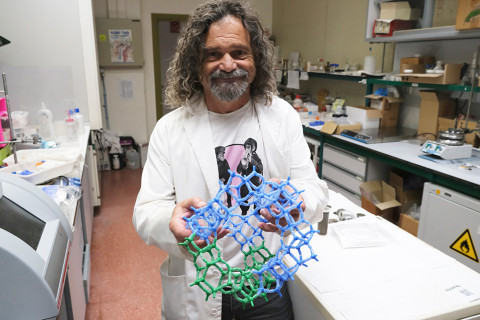Miguel Camblor will prepare the world's most porous zeolites to eliminate "indestructible" contaminants such as DDT and PFAS

The Materials Science Institute of Madrid (ICMM-CSIC) has been awarded one of the 16 synergistic R&D projects granted by the Community of Madrid this year. The project involves a financial endowment of more than €760,000 for the development of a competitive research project over three years, and will culminate in an ultra-competitive proposal to obtain one of the prestigious European ERC Synergy Grants.
The ICMM-CSIC project is led by researcher Miguel Camblor, a world-renowned expert in zeolites, and will be developed in collaboration with Carolina Belver, a researcher at the Autonomous University of Madrid and an expert in photocatalysis and electrocatalysis. Combining their knowledge, they will functionalize the ultraporous zeolites discovered by Camblor's team so that they eliminate persistent organic compounds: "These are highly toxic elements at low concentrations that accumulate in the environment and eventually reach living organisms," explains the ICMM-CSIC researcher.z
Zeolites are materials with a crystalline structure composed of aluminum, silicon, and oxygen. Their main characteristic is that they contain an internal network of channels and cavities of nanoscopic size (one millionth of a millimeter), making them very useful in applications such as catalysis, gas absorption, and decontamination. Camblor's team has been working on them for decades and, in fact, last year they created the most porous zeolite in the world.
"We have already used the ultraporous zeolites we discovered in the laboratory in catalysis and pollutant absorption, but now we are going a step further and are going to degrade these pollutants, eliminating them," says Camblor, who adds that their strategies to achieve their goal will be in different directions.
Persistent organic compounds
The Persistent organic compounds (POPs) are chemical substances that pose a threat to human health and the environment worldwide because they do not degrade in the environment; they are bioaccumulative (i.e., they are incorporated into the tissues of living beings); they are toxic to health and have the potential for long-distance transport, "potentially reaching regions where they have never been produced or used," explains the Ministry of Ecological Transition and Demographic Challenge.
One of the best-known POPs is DDT (dichlorodiphenyltrichloroethane), an insecticide that has been widely used for decades and now persists in the environment. It is blamed for the transmission of pests and diseases such as malaria, as it acts on the motor and sensory nerves of invertebrates. Other dangerous pollutants are PFAS (per- and polyfluoroalkyl substances): "very difficult to eliminate because the carbon-fluorine bond is very strong," explains Camblor.
"These are materials that have been used in industry in different ways, as additives in plastics, herbicides... and now pose a serious problem because they are present in the environment and cannot be degraded," warns the researcher. This project now has three years to take important steps toward their elimination.
Instituto de Ciencia de Materiales de Madrid (ICMM)
Sor Juana Ines de la Cruz, 3
Cantoblanco, 28049
Madrid, España
Telephone: (+34) 91 334 90 00
Email: @email
Communication Office: @email

Acknowledge the Severo Ochoa Centres of Excellence program through Grant CEX2024-001445-S/ financiado por MICIU/AEI / 10.13039/501100011033

Contacto | Accesibilidad | Aviso legal | Política de Cookies | Protección de datos